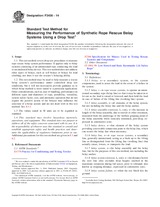We need your consent to use the individual data so that you can see information about your interests, among other things. Click "OK" to give your consent.
ASTM F2436-14
Standard Test Method for Measuring the Performance of Synthetic Rope Rescue Belay Systems Using a Drop Test
STANDARD published on 1.12.2014
The information about the standard:
Designation standards: ASTM F2436-14
Note: WITHDRAWN
Publication date standards: 1.12.2014
SKU: NS-53870
The number of pages: 8
Approximate weight : 24 g (0.05 lbs)
Country: American technical standard
Category: Technical standards ASTM
The category - similar standards:
Annotation of standard text ASTM F2436-14 :
Keywords:
belay, drop test, performance,, ICS Number Code 13.340.60 (Protection against falling and slipping)
Additional information
| Significance and Use | ||||||
|
5.1 The types of rope rescue systems to which this test method apply use a tensioned mainline and untensioned belay line. If a fall occurs because of a mainline system failure or misuse, considerable energy must be absorbed by the belay for a successful arrest. This drop test method simulates a “worst case” condition when systems are operated as designed, and is designed to help evaluate and compare the performance of various rope rescue belay systems under such conditions. (See Note 1.) The successful catching of a load does not imply that the tested system is suitable for any and all belaying. See X1.2. Note 1: Higher forces may be encountered under some
circumstances, such as the belay being operated with excessive
slack.
|
||||||
| 1. Scope | ||||||
|
1.1 This test method covers drop test procedures to measure rope rescue belay system performance. It applies only to belay systems consisting of an untensioned rope connecting the load to an anchored belay device. This test method does not address other types of belays, such as self-belays or belays for lead climbing, nor does it test the rescuer's belaying ability. 1.2 This test method may be used to help measure a rescue belay system's performance under controlled drop test conditions, but it will not necessarily provide guidance as to which belay method is most suited to a particular application. Other considerations, such as ease of handling, performance on different types and diameters of rope, portability, versatility, system safety factor, cost, and automatic operation that do not require the positive action of the belayer may influence the selection of a belay system and are not dealt with in this test method. See X1.1. 1.3 The values stated in SI units are to be regarded as standard. 1.4 This standard may involve
hazardous materials, operations, and equipment. This standard does
not purport to address all of the safety concerns associated with
its use. It is the responsibility of whoever uses this standard to
consult and establish appropriate safety and health practices and
determine the applicability of regulatory limitations prior to use.
Standard Specification for Masses Used in
Testing Rescue Systems and Components CI?1801-98 Low Stretch and Static Kernmantle Life
Safety Rope Available from Cordage Institute, 994 Old Eagle School
Rd., Wayne, PA 19087, http://www.ropecord.com. Standard Practice for Conditioning and
Testing Textiles |
We recommend:
Updating of laws
Do you want to be sure about the validity of used regulations?
We offer you a solution so that you could use valid and updated legislative regulations.
Would you like to get more information? Look at this page.




 Cookies
Cookies
